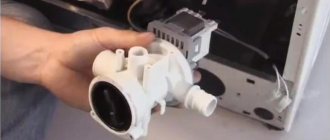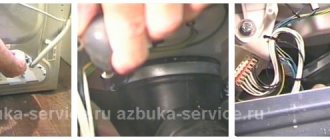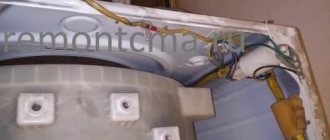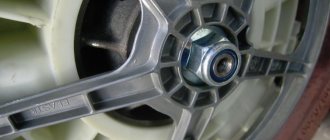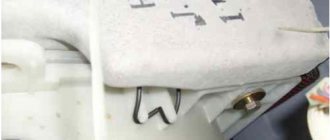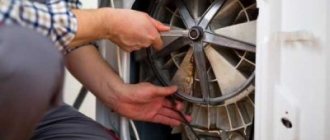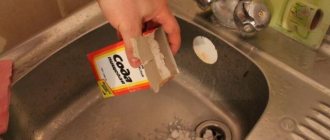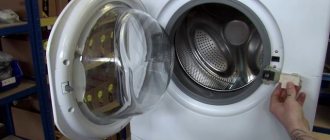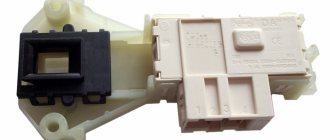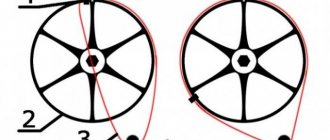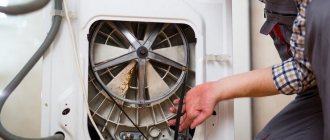A washing machine, like any technical device, is a complex device, the “heart” of which is the power unit. It is this that ensures the rotation of the drum, converting electric current into mechanical movements. Any asynchronous type power unit has brushes in its structure, which often fail. Replacing the motor brushes of a washing machine is not such a complicated process; it can be done independently.
What are they needed for
So, as it became clear, brushes are required for normal operation of an electric motor. This is a small but necessary part, which ensures the transfer of electrical energy to the rotor winding of the power unit, due to which, in fact, it rotates.
Brushes wear out over time, so they need to be replaced from time to time. And if you delay this, the problem may turn out to be much worse and the power unit itself will have to be changed.
Purpose of brushes for a washing machine
Electric brushes for a home washing machine are usually shaped like a cylinder or parallelepiped, pressed against the motor commutator by a steel spring. On the back side, a wire is inserted into them, ending with a copper contact for inclusion in the electrical circuit. With their help, current is transferred to the windings of the rotating rotor, which is necessary for normal operation of the motor.
To ensure a tight fit, the brushes are pressed against the armature with great force, which leads to their gradual abrasion. The material from which such parts are made has certain requirements. It must be durable, electrically conductive and have minimal friction. Graphite and its derivatives fully possess these qualities.
For information! During operation, the working surface of the brush takes on a rounded shape, repeating the contours of the commutator, which ensures maximum contact area and excellent glide.
Types of brushes
There are three main types of brushes used in electrical engineering:
- carbon-graphite;
- electrographite;
- metallographic with inclusions of copper and tin.
The second and third options have increased wear resistance, but are expensive. They are installed on critical equipment that requires high reliability. Economical carbon products with acceptable performance properties are suitable for household devices.
Length of service life
The original factory-installed motor brushes on most washing machines typically last between 5 and 10 years. The replacement period greatly depends on the manufacturer and the intensity of use of the washing machine.
Sometimes, due to the breakdown of a serious component, the owner decides to purchase new household appliances without ever changing the brushes on the old unit.
Types of parts
The main difference between all brushes is their pressing element, which can be:
- copper-graphite;
- carbon-graphite;
- electrographitized.
Washing machines often use carbon types, which are not so expensive, but quite reliable.
When do you need to replace brushes?
The motor is always located inside the body of the automatic machine. It is not possible to monitor his condition, and there is no need for this. The need to replace brushes on a washing machine in use is judged by indirect signs:
- sudden stop of the electric motor without obvious external damage;
- During operation of the motor, a loud cracking sound is heard, which often occurs when the graphite elements of the brushes are destroyed;
- the engine does not pick up speed, which results in poor spinning of the laundry;
- the appearance of a characteristic burning smell;
- the display shows the corresponding error code.
Advice! The listed signs do not clearly indicate that the brushes are broken, but they should be used to check the cause of the problem.
Tips for choosing
If you find that the brushes require replacement, it’s time to go to a specialized store. How to avoid buying the wrong parts?
When buying brushes, you should follow simple rules:
- In order not to experience problems with installation and subsequent operation, you need to buy brushes from the same manufacturer as the old ones. To do this, you will need to visit a specialized store, where you will need to name the brand of your washing machine or the engine installed on it. It is better to take the dismantled elements with you to compare them with the product you are purchasing.
- The kit always includes two brushes. Even if one part is broken, both need to be replaced in order to achieve uniform pressure. Otherwise, the service life of the new element may be reduced.
- For normal operation, the uniformity of graphite bars operating in harsh conditions is important. Be sure to inspect them when purchasing. Even small chips and cracks can lead to rapid destruction. For the same reason, avoid installing used parts.
When to replace
There are several signs by which you can definitely recognize brush wear:
- Unexpected cessation of operation of the electric power unit, for example stopping during washing. If this is not accompanied by a voltage surge or mechanical damage, then the reason is precisely the wear of the brushes.
- During washing, a crackling or other unknown noise appeared.
- Significant reduction in power of the electric power unit.
- The smell of burnt wiring and burning from the washing machine.
- An error code appears on the display.
These are just the most basic reasons for brush abrasion, but there may be others that only a specialist can recognize.
Replacing brushes will not present any difficulties even for those people who have never encountered this problem before, but the process must be approached as responsibly as possible.
How to understand what needs to be replaced (reasons, service life)?
The standard service life of the device during normal use is about 4-5 years, however, with active daily washing, the period decreases. If a malfunction occurs, the average user cannot determine with complete certainty the cause of the breakdown without disassembling the device. One can only assume that the brushes have failed based on the following external signs:
- the motor loses power and rotates the drum at a slow speed, and with a large load it cannot move the drum from its place. The drum may also stop unexpectedly in the middle of a wash program;
- during self-diagnosis of the unit, an error code associated with engine failure is displayed on the screen;
- insufficient spin of laundry after washing due to a decrease in the number of revolutions;
- extraneous non-standard noise and vibration;
- the motor sparks or there is smoke with the smell of burnt wiring.
Based on these visual signs, one can only assume there is a problem, but to be sure, you will need to disassemble the washing machine yourself or contact a service center.
Preliminary manipulations with the machine
First you need to disassemble the washing machine:
- Disconnect the device from the power supply and water supply/discharge system.
- Remove the rear protective cover.
- Remove the belt from the pulley.
- We disconnect the motor from the power supply.
- We remove the engine itself.
It is worth understanding that the disassembly process may be slightly different, based on the specific manufacturer and model of the machine.
How to choose replacement brushes
The functioning of the washing machine and the service life of the graphite elements directly depend on the correct choice of brushes. All brushes must be the same size, since installing parts with different spring stiffness or other material carries a high probability of failure of the entire unit.
You should only buy brushes from trusted sellers, making sure to write down or remember the brand of your washing machine. The easiest way to purchase spare parts is through online stores or service centers. Original products can cost from 800 to 3000 rubles, but to reduce the cost you can buy universal brushes, they cost from 300 to 500 rubles. By purchasing brushes for a specific model, you eliminate the possibility of poor-quality repairs, which are often carried out with mechanical adjustment of the brushes to the required dimensions. Even considering that replacing brushes is not a complex repair, it is better to have it done by specialists who provide a guarantee for the repair.
Electric brushes are an indispensable element in a washing machine. If you hear a characteristic crackling sound while the automatic machine is running, then most likely the brushes on the motor in your design have worn out. How to change brushes in a washing machine with your own hands?
This problem must be eradicated, if possible, at the time of its discovery, so as not to worsen the situation of the washing machine. Electric brushes can be purchased at a service center or in a special store.
Replacement process
The entire replacement process will be shown using the Gorenye brand as an example, but it is actually suitable for other brands:
- The power unit is laid on its side and the mounting bolts are removed from the brushes, after which the latter are removed.
- On the other side of the engine, identical manipulations are performed.
- Brushes that have exhausted their working supply have a rod length of no more than 1.5 cm (if the brushes are longer, then the problem is not with them).
- The power unit manifold is being cleaned.
- New parts are mounted and secured with screws.
Attention! The brushes must be replaced in pairs.
Next, you need to put the engine in place and do all other manipulations in reverse order. Once everything is connected, be sure to check the quality of its operation. If it works a little better or even louder, most likely everything was done correctly. If there is an unpleasant or unusual sound, the problem is most likely not solved.
Attention! It is not recommended to overload the drum for the first 10 washes after replacement.
How to change brushes on a washing machine
Some manufacturers of household power tools list quick-release carbon brushes as advantages of their models. This is really important, because when performing work, time is more valuable than gold, and brushes have to be changed quite often due to difficult working conditions. With washing machines the situation is somewhat different. To assess their condition or replace it, you must:
ADVICE! An excellent solution would be if all disassembly operations at each stage are recorded on a smartphone camera. This will make it possible to correctly install all elements and electrical wires when assembling the unit. Remember which direction the brushes are pointing!
After removing the engine, you need to unscrew the brush holder mounting bolts, then disconnect the contact terminals. If the brushes on the motors are less than one and a half centimeters long, or if cracks or broken contacts are visible on them, then they must be replaced.
If only one brush is severely worn or damaged, both parts must be replaced.
Before installing new brushes to replace the old ones, it is necessary to inspect the condition of the stator and rotor, clean them of dust, dirt, and graphite residues using a dry rag soaked in medical alcohol. If there are small scratches and nicks on the contact surface of the commutator (the brushes are adjacent to it), they can be carefully removed using the finest sandpaper, then wiped with alcohol. After all the manipulations, you can install new elements with mandatory reliable fastening using locking bolts.
Having assembled the washing machine in the reverse order of disassembly, you can begin testing. To do this, you need to turn on the washing machine in one of the washing modes (without clothes at idle), and observe the operation of the device. If there is slight sparking and not much noise in the engine, this is normal in the first minutes of operation. Over time, the surfaces of the brushes will rub against the commutator and the sparks will disappear. During the first wash cycles, you should not overload the drum with laundry.
Replacing brushes yourself
Replacing them on a washing machine is not at all difficult. However, this work must be approached very responsibly. During the repair process, you will need tools such as pliers, sandpaper and screwdrivers of various sizes.
Preliminary disassembly
Disassembling the washing machine consists of several stages:
- First of all, turn off the power to the machine (disconnect from the power supply).
- To replace, you need to get to the back of the washing machine. This will probably require disconnecting communications (sewage and water supply).
- Remove the back wall of the washer. To do this, most likely, you will need to unscrew the screws.
- When the back wall is removed, you will see a pulley and a tensioned belt that needs to be removed. In order to remove the belt, you need to pull it towards you a little, and then carefully turn the pulley.
- Next, disconnect the electric motor from the power supply. This is done very simply: pull out the connector with wires from the engine socket.
- Then pull out the washer motor. To do this, you need to unscrew several bolts.
It is important to note that the disassembly diagram for your machine may differ slightly from the one described above. It all depends on the model of the washing machine.
Replacing parts
To replace electric motor brushes you must:
Motor with worn brushes
- Place the washing machine motor on the side where the brush body is located. Then you need to unscrew the mounting bolts.
- Disconnect the brushes from the washing machine motor. At this stage, it is advisable to photograph the location of the washer brushes and the sharpening points on them. If new parts are installed incorrectly, sparking will occur in the machine motor.
- then remove the part from the back of the engine,
- then carefully inspect the dismantled parts. For spent elements, as a rule, the length of the rod does not exceed 15 millimeters. If the rod lengths are greater, then most likely the reason is not them.
- clean the motor commutator. There will be black dust from the brushes on it. If scratches are identified, it is recommended to clean them with sandpaper.
- Install new motor brushes and then secure them with screws.
It should be noted that washing machine brushes are always replaced in pairs.
Final stage of repair
At the final stage of car repair, install the washing machine motor and return it to its original place. All necessary steps are performed in reverse order:
- installing the motor in place. To do this, secure it with bolts or other fasteners.
- connecting the power cable,
- then put on the belt. It is first placed on the engine, and then on the pulley. Scroll the last until the belt takes its place.
- Install the back cover of the washing machine.
- Upon completion of the repair work, test the operation of the washing machine. To do this, turn on any program and carefully listen to the operation of the motor. It should work as usual or a little louder. The main signs of a malfunction are crackling, grinding or loud noise.
It is recommended not to overload the machine drum during the first 10 washes. At this time, the new brushes will be worn in.
